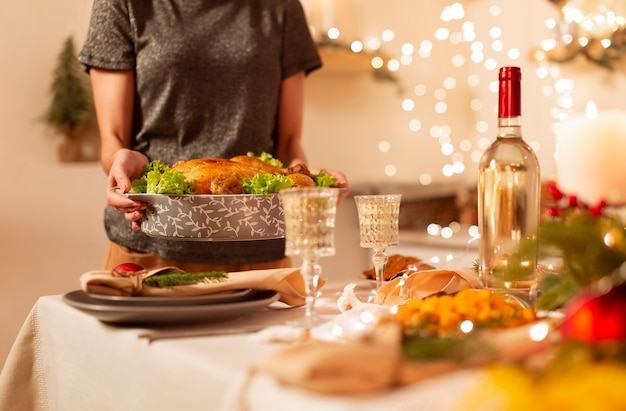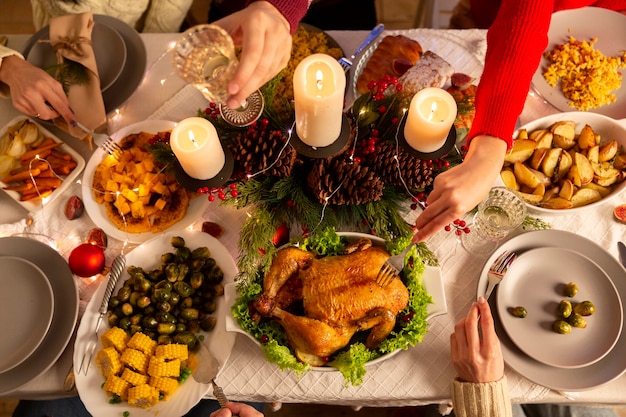
The Importance of Meal Planning During the Holiday Season
The holiday season is a time for celebration, togetherness, and indulgence in delectable meals.
However, with the excitement of hosting family gatherings and festive parties, it’s easy to get carried away with food preparation, resulting in excessive waste or insufficient portions.
Proper meal planning is crucial to ensure a stress-free and enjoyable experience for you and your guests.
By carefully considering factors such as guest count, dietary restrictions, and portion sizes, you can strike the perfect balance, avoiding both food waste and leaving your loved ones hungry.
Key Considerations in Holiday Meal Planning:
It’s essential to lay the groundwork by addressing three crucial aspects: headcount, menu planning, and a leftovers strategy.
Headcount:
Accurately determining the number of guests is the foundation of a successful meal plan. Knowing the exact headcount allows you to calculate portion sizes and adjust recipes accordingly, whether it’s a cozy family gathering, an intimate holiday tete-a-tete with friends, or a grand soiree.
Determine of you invitees will bring over their kids so you have specific holiday meal for particular ages.
Meal Planner & Menu Planning:
Consider incorporating various dishes catering to different tastes and dietary needs. Striking a balance between traditional favorites and innovative creations can add an exciting twist to your holiday spread.
In planning your holiday meals, have a good mix of simple recipes or easy meals and those requiring at least a week of preparation. This include recipes that involve meat marination for a period of time and would probably require a slow cooker, soup recipes that you need to reduce for days, and desserts that you need to bake.
Before you grocery shop, take a long hard look at your pantry to check all the ingredients, determine what’s available and not, and draw your shopping lists accordingly. You must also have an idea if some of your guests are staying over for a day or two, which means you need to do meal planning and cooking for breakfast, lunch, snacks, and dinners – depending on how long they will stay.
Leftovers Strategy:
While leftovers are an inevitable part of holiday feasting, having a plan in place to manage them can prevent waste and maximize their potential. Consider creative ways to repurpose leftovers into new dishes, or plan to send guests home with bags filled with delicious remnants.
Practical Tips for Meal Preparation
Holiday cooking for large families during the holidays can be a daunting task, but if you prep ahead, you can ensure that everyone leaves the table satisfied without generating excessive waste.
Here are some tips to help you cook the right amount of food for your extended clan:
Estimate Portion Sizes:
When catering to a large group, it’s essential to have a clear understanding of portion sizes. Refer to recommended serving sizes for common holiday dishes, which we’ll cover in detail later in this article.
Food Safety and Storage:
Proper food handling and storage practices are essential during the holiday season, especially when dealing with large quantities of food. Follow recommended guidelines for refrigeration, freezing, and reheating to maintain the quality and safety of your dishes.
Batch Cooking:
Many dishes, such as soups, stews, and casseroles, can be easily scaled up to accommodate larger groups. Consider preparing these dishes in advance and storing them properly until serving time.
Potluck Style:
If you’re hosting an exceptionally large gathering, consider adopting a potluck-style approach. Assign different dishes to various family members or guests, allowing them to contribute their culinary specialties.
Proportions and Serving Sizes for Common Noche Buena Dishes

To ensure you cook the right amount of food for your holiday feast, it’s essential to understand the recommended serving sizes for common Noche Buena dishes. Here’s a handy guide to help you plan and portion your holiday spread:
Pasta (Spaghetti or Carbonara)
Recommended serving size: 100-120g of uncooked pasta per adult; 80g for children.
Main Dish (e.g., Lechon, Ham, or Roasted Chicken)
Lechon/roasted pork: 200-250g per person.
Ham: 150-200g per person.
Roasted chicken: 1 whole chicken for every 3-4 adults.
Rice, Sweet Potatoes, Mashed Potatoes or Baked Potatoes
Portion size: 1 cup (uncooked) for every 2-3 guests.
Side Dishes (e.g., Lumpiang Shanghai, Potato Salad)
Lumpiang Shanghai: 4-5 pieces per person.
Potato salad: 1 cup per guest.
Desserts (e.g., Fruit Salad, Leche Flan)
Fruit Salad: 1 cup per person.
Leche Flan: 1 llanera can serve 6-8 people.
Drinks
Soft drinks: 1 liter for every 4 guests.
Juice: 1 liter for every 3 guests.
Dealing With Dietary Restrictions During Holiday Meals

While the holiday season is often associated with indulgence and abundance, it’s crucial to be mindful of the dietary restrictions and preferences of your guests.
Communication is Key:
Before the event, reach out to your guests and inquire about any dietary restrictions or preferences they may have.
This could include allergies, intolerances, religious or cultural dietary guidelines, or personal choices such as vegetarianism or veganism.
Menu Planning with Flexibility:
When crafting your holiday menu, incorporate dishes that can be easily adapted to accommodate different dietary needs.
For example, prepare a vegetable-based main dish for vegetarians or vegans, or offer gluten-free alternatives for those with gluten sensitivities.
Label and Identify Dishes:
Clearly label or identify dishes that cater to specific dietary restrictions. This will help guests make informed choices and avoid any accidental consumption of foods they cannot or choose not to eat.
Separate Preparation Areas:
If you’re preparing dishes with common allergens, such as nuts or shellfish, consider setting up a separate preparation area to prevent cross-contamination during prep work.
This simple step can provide peace of mind for guests with severe food allergies.
Be Open to Substitutions:
Remain flexible and open to making substitutions or modifications to recipes if requested by guests with dietary restrictions.
This could involve swapping out ingredients, adjusting cooking methods, or offering alternative options.
Tips to Avoid Food Waste
While holiday feasts are meant to be abundant and celebratory, it’s crucial to strike a balance between indulgence and responsible consumption.
Here are some tips to help you minimize waste during your holiday celebrations:
Repurpose Leftovers:
Get creative with repurposing leftovers into new and delicious dishes. Leftover turkey or ham can be transformed into sandwiches, soups, or casseroles.
Vegetables can be incorporated into frittatas or stir-fries, while bread can be turned into croutons or bread pudding.
Share with Guests:
If you find yourself with an abundance of leftovers, consider sending your guests home with containers filled with the delicious remnants after the dinner night.
Donate or Compost:
If you still have excess food that cannot be repurposed or shared, consider donating it to local food banks or shelters. Many organizations gladly accept unopened, non-perishable items or fresh produce.
Conclusion

Remember to embrace practical techniques like batch cooking, scaling recipes, and adhering to food safety guidelines to streamline the meal prep process.
Additionally, be mindful of accommodating dietary restrictions and implementing strategies to reduce food waste, such as portion control, repurposing leftovers, and sharing with guests.
With these tips and insights, you’ll be well-equipped to navigate the challenges of holiday dinner meal planning, ensuring a memorable and sustainable celebration filled with delicious food and cherished moments with your loved ones.

Celebrate Life’s Milestones in Camella!
House and Lot & Condominium for Sale in the Philippines


